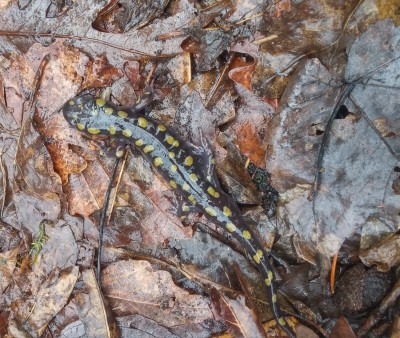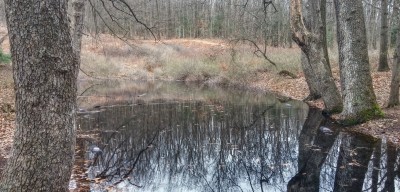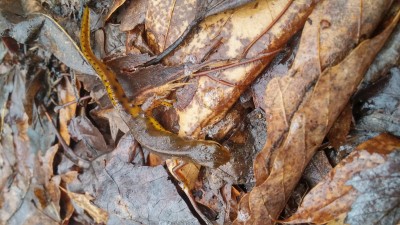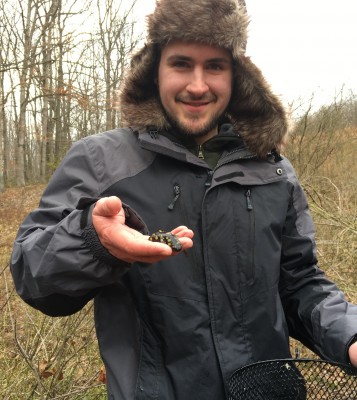On a rainy night on the first of March, a large mole salamander has emerged from the ground after spending almost the entire year just beneath the surface of the earth. This amphibian, of the mole salamander family, is called a spotted salamander. He is preparing to begin his journey to a very special place. He will begin a unique courtship with a female in hope of passing on his genes to future generations.

This spotted salamander has recently completed his migration to a vernal pool. Photo taken on the second day of March 2017.
Photo by Jake Smith
Have you ever discovered a mysterious small pond in the forest that may look as if it was just a giant, lifeless puddle full of rotting leaves or a place where mosquito larvae are plotting to pester you once they emerge with wings? Or perhaps it gave a similar appearance to the freshly brewed coffee that you sipped this morning. This “puddle” may also mysteriously disappear during certain times of the year with only rain water to keep it in its existence. If you have discovered a pond like this, consider yourself lucky! This is a vernal pool, a vital life-supporting place for hundreds of species of animals. Please join me as we explore this living ecosystem and crucial habitat.

While many vernal pools are about the size of your living room, some can be as big as an acre in size.
Photo by Jake Smith
The spotted salamander is making his journey to a vernal pool. He is not alone. Hundreds of spotted salamanders will leave the dark ground to venture to the pool all for the same reason, all on the same night. These salamanders are termed “explosive breeders.” They will come to the water during a short period to breed. These types of vernal pool migrations occur with many species of amphibians such as wood frogs, spring peepers, Jefferson salamanders, spotted salamanders, and eastern newts.
Before we dig deeper into the life that relies on these pools, we should unfold the characteristics that help us identify a vernal pool. First, the origin of the word “vernal” means “occurring in the spring.” With that being said, a vernal pool is a temporary pool that disappears during drier times of the year. There also must be no inlet or outlet of water to or from the pool. Another fairly simple characteristic is that you will not find any fish living in the water. With these specific indicators, you have already discovered that the pool is only temporary. One of the last indicators is that fairy shrimp will most likely be found swimming around in the pool. These are extremely small (but still visible with the naked eye) crustaceans that swim upside down and feed on algae.
Once you have identified your vernal pool, you are now ready to begin your exciting search for amphibians. Often, if you venture to a vernal pool at the right moment, you may see hundreds of the same species all migrating to the water at once. The time of year and weather conditions are the main factors that influence a specific species of migratory animals. For the most part, many species of migrating amphibians in Pennsylvania will travel to these breeding locations on the first rainy days of February, March, and April.

The red-spotted newt or eastern newt is often found in vernal pools and other areas of water in a forest.
Photo by Jake Smith
As you may have already realized, vernal pools are extremely important for the survival of many species. Unfortunately, a large amount of them are disappearing or becoming polluted by a variety of contaminants. The absence of breeding grounds for the amphibians can have a dramatic impact on their populations, which in turn will have an impact on the species above and below them on the food chain. The main reasoning behind this disappearance is because people perceive the pools as lifeless areas of water. They are often leveled for housing development, contaminated with fertilizers from a nearby farm, or enlarged to create a more pleasant looking pond or lake.
The next time you are enjoying the natural beauty of the forest and come across a small body of water, I challenge you to take a moment and think about all the species of animals that need this area to survive. The importance of vernal pools is a topic that can easily be forgotten. The next time you stumble upon a salamander or newt, I am confident that the exciting moment will be something that you may never forget.

Jake Smith is excited to find a spotted salamander while assisting with an extensive vernal pool research project.
Photo by Claudia Rosen
